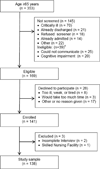Malnutrition among cognitively intact, noncritically ill older adults in the emergency department
- PMID: 25129819
- PMCID: PMC4275371
- DOI: 10.1016/j.annemergmed.2014.07.018
Malnutrition among cognitively intact, noncritically ill older adults in the emergency department
Abstract
Study objective: We estimate the prevalence of malnutrition among older patients presenting to an emergency department (ED) in the southeastern United States and identify subgroups at increased risk.
Methods: We conducted a cross-sectional study with random time block sampling of cognitively intact patients aged 65 years and older. Nutrition was assessed with the Mini Nutritional Assessment Short-Form (0 to 14 scale), with malnutrition defined as a score of 7 or less and at risk for malnutrition defined as a score of 8 to 11. The presence of depressive symptoms was defined as a Center for Epidemiological Studies Depression-10 score of 4 or more (0 to 10 scale).
Results: Among 138 older adults, 16% (95% confidence interval [CI] 11% to 23%) were malnourished and 60% (95% CI 52% to 68%) were either malnourished or at risk for malnutrition. Seventeen of the 22 malnourished patients (77%) denied previously receiving a diagnosis of malnutrition. The prevalence of malnutrition was not appreciably different between men and women, across levels of patient education, or between those living in urban and rural areas. However, the prevalence of malnutrition was higher among patients with depressive symptoms (52%), those residing in assisted living (44%), those with difficulty eating (38%), and those reporting difficulty buying groceries (33%).
Conclusion: Among a random sample of cognitively intact older ED patients, more than half were malnourished or at risk for malnutrition, and the majority of malnourished patients had not previously received a diagnosis. Higher rates of malnutrition among individuals with depression, difficulty eating, and difficulty buying groceries suggest the need to explore multifaceted interventions.
Copyright © 2014 American College of Emergency Physicians. Published by Elsevier Inc. All rights reserved.
Figures
References
-
- Salvi F, Giorgi R, Grilli A, et al. Mini Nutritional Assessment (short form) and functional decline in older patients admitted to an acute medical ward. Aging Clin Exp Res. 2008;20:322–328. - PubMed
-
- Cereda E, Valzolgher L, Pedrolli C. Mini nutritional assessment is a good predictor of functional status in institutionalised elderly at risk of malnutrition. Clin Nutr. 2008;27:700–705. - PubMed
-
- Crogan NL, Pasvogel A. The influence of protein-calorie malnutrition on quality of life in nursing homes. The journals of gerontology Series A, Biological sciences and medical sciences. 2003;58:159–164. - PubMed
-
- Correia MI, Waitzberg DL. The impact of malnutrition on morbidity, mortality, length of hospital stay and costs evaluated through a multivariate model analysis. Clin Nutr. 2003;22:235–239. - PubMed
-
- Guigoz Y, Vellas B, Garry PJ. Mini Nutritional Assessment: a practical assessment tool for grading the nutritional state of elderly patients. In: Vellas BJ, Guigoz Y, Garry PJ, Albarede JL, editors. The mini nutritional assessment: MNA Nutrition in the elderly. Paris: Serdi Publishing Company; 1997.
MeSH terms
Grants and funding
LinkOut - more resources
Full Text Sources
Other Literature Sources
Medical


